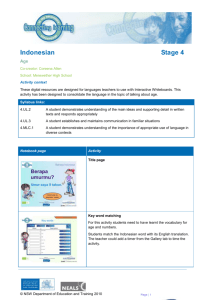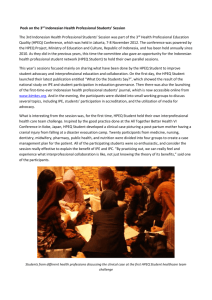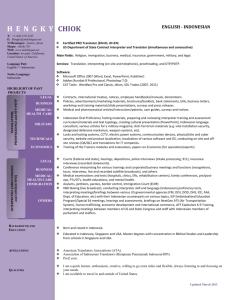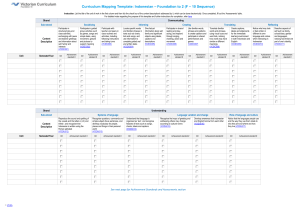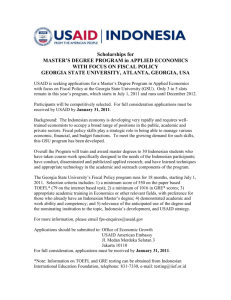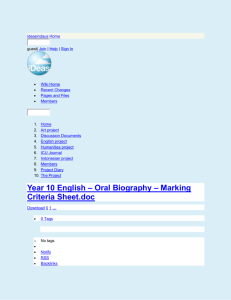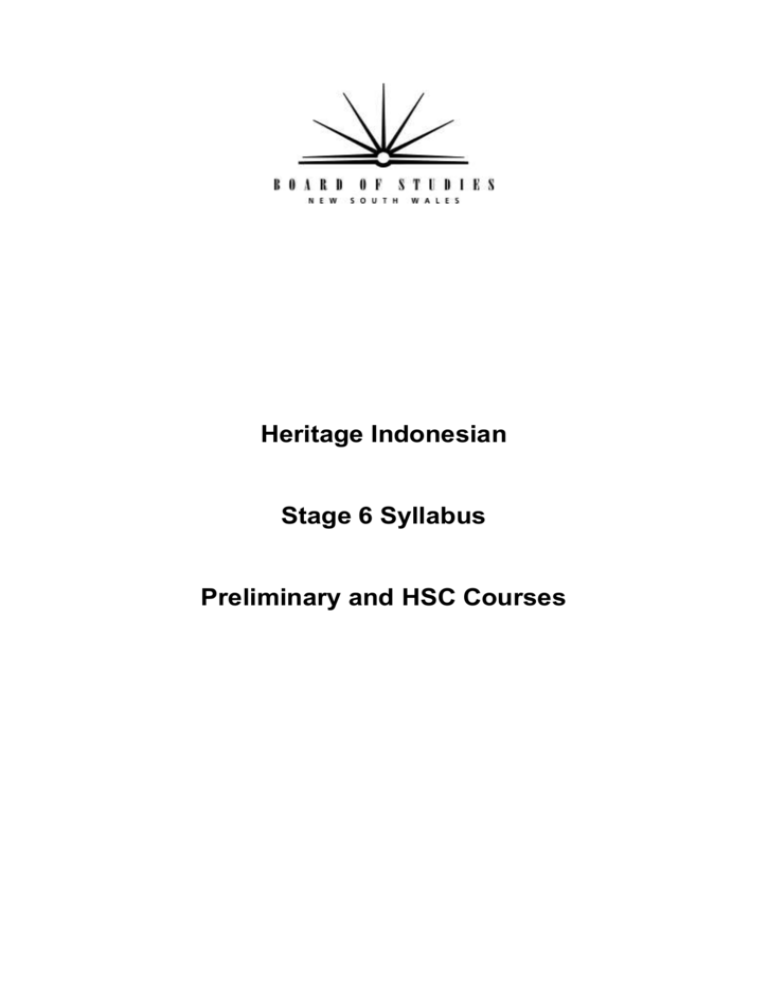
Heritage Indonesian
Stage 6 Syllabus
Preliminary and HSC Courses
© 2010 Board of Studies NSW for and on behalf of the Crown in right of the State of New South Wales, 2010.
This document contains Material prepared by the Board of Studies NSW for and on behalf of the Australasian Curriculum,
Assessment and Certification Authorities, in collaboration with:
Victorian Curriculum and Assessment Authority
SACE Board of South Australia
Queensland Studies Authority
Curriculum Council of Western Australia
Northern Territory Board of Studies
Tasmanian Qualifications Authority
New Zealand Qualifications Authority.
All rights reserved. No part of the Material may be reproduced in Australia or in any other country by any process, electronic
or otherwise, in any material form or transmitted to any other person or stored electronically in any form without the prior
written permission of the Board of Studies NSW, except as permitted by the Copyright Act 1968. School students in Australia
and teachers in schools in Australia may copy reasonable portions of the Material for the purposes of bona fide research or
study.
When you access the Material you agree:
to use the Material for information purposes only
to reproduce a single copy for personal bona fide study use only and not to reproduce any major extract or the entire
Material without the prior permission of the Board of Studies NSW
to acknowledge that the Material is provided by the Board of Studies NSW
not to make any charge for providing the Material or any part of the Material to another person or in any way make
commercial use of the Material without the prior written consent of the Board of Studies NSW and payment of the
appropriate copyright fee
to include this copyright notice in any copy made
not to modify the Material or any part of the Material without the express prior written permission of the Board of
Studies NSW.
The Material may contain third party copyright materials such as photos, diagrams, quotations, cartoons and artworks. These
materials are protected by Australian and international copyright laws and may not be reproduced or transmitted in any
format without the copyright owner’s specific permission. Unauthorised reproduction, transmission or commercial use of
such copyright materials may result in prosecution.
The Board of Studies has made all reasonable attempts to locate owners of third party copyright material and invites anyone
from whom permission has not been sought to contact the Copyright Officer, ph (02) 9367 8289, fax (02) 9279 1482.
Published by
Board of Studies NSW
GPO Box 5300
Sydney NSW 2001
Australia
Tel: (02) 9367 8111
Fax: (02) 9367 8484
Internet: http://www.boardofstudies.nsw.edu.au
May 2010
2010362
Disclaimer
The views expressed herein do not necessarily represent the views of the Australian Government
Department of Education, Employment and Workplace Relations.
Acknowledgement
This work was funded by the Australian Government Department of Education, Employment
and Workplace Relations under the School Languages Program.
Contents
1
The Higher School Certificate Program of Study................................................ 4
2
Introduction to Heritage Indonesian in the Stage 6 Curriculum .......................... 5
2.1 The Language .......................................................................................... 5
2.2 Description of Target Group ..................................................................... 5
2.3 Rationale .................................................................................................. 6
Continuum of Learning ....................................................................................... 7
Aims
....................................................................................................... 8
Objectives ....................................................................................................... 8
Course Structure ................................................................................................ 9
Objectives and Outcomes ................................................................................ 10
7.1 Table of Objectives and Outcomes ........................................................ 10
7.2 Key Competencies ................................................................................. 11
Content
..................................................................................................... 12
8.1 Content of the Heritage Indonesian Preliminary and HSC Courses ....... 13
8.2
Issues, Perspectives and Contexts ........................................................ 16
8.2.1 Issues .......................................................................................... 16
8.2.2 Perspectives ............................................................................... 17
8.2.3 Contexts and texts ....................................................................... 17
8.3 Personal Investigation ........................................................................... 18
8.4 Tasks .................................................................................................... 20
8.5 Grammar ................................................................................................ 20
Other Considerations ....................................................................................... 26
9.1 The place of English .............................................................................. 26
9.2 The role of digital technologies .............................................................. 26
9.3 Dictionaries ............................................................................................ 27
Assessment and Reporting .............................................................................. 27
Post-school Opportunities ................................................................................ 28
3
4
5
6
7
8
9
10
11
Heritage Indonesian Stage 6 Syllabus
1
The Higher School Certificate Program of Study
The purpose of the Higher School Certificate program of study is to:
provide a curriculum structure which encourages students to complete secondary
education
foster the intellectual, social and moral development of students, in particular
developing their:
- knowledge, skills, understanding and attitudes in the fields of study they
choose
- capacity to manage their own learning
- desire to continue learning in formal or informal settings after school
- capacity to work together with others
- respect for the cultural diversity of Australian society
provide a flexible structure within which students can prepare for:
- further education and training
- employment
- full and active participation as citizens
provide formal assessment and certification of students’ achievements
provide a context within which schools also have the opportunity to foster the
students’ physical and spiritual development.
4
Heritage Indonesian Stage 6 Syllabus
2
Introduction to Heritage Indonesian in the Stage 6 Curriculum
2.1
The Language
The language to be studied and assessed is the modern standard version of
Indonesian, the official language of Indonesia. Students should be familiar with formal
and informal levels of the language, including colloquial language. During their course of
study, students may encounter some regional variations of the language.
While students may understand a wide range of informal usage, they will not be
expected to reproduce the full range.
2.2
Description of Target Group
Heritage Indonesian language students are typically those who have been brought up in
a home where the Indonesian language is used and who have a connection to
Indonesian culture. They have some degree of understanding and knowledge of
Indonesian, although their oral proficiency is typically more highly developed than their
proficiency in the written language. These students have received all or most of their
formal education in schools where English (or another language different from
Indonesian) is the medium of instruction. They can therefore be considered to some
extent bilingual, with English or the other language being the predominant language.
This course recognises the varying degrees of affinity with the culture of Indonesianspeaking communities and the diversity of knowledge and skills in Indonesian that
students will have acquired prior to enrolling in the Heritage language course. At entry
level to the course, students will have typically undertaken:
some study of Indonesian in a community, primary and/or secondary school in
Australia, and/or
formal education in a school where Indonesian was the medium of instruction up to
the age of ten.
Eligibility criteria apply (see Language Courses Eligibilty Criteria at
http://www.boardofstudies.nsw.edu.au/syllabus_hsc/pdf_doc/heritage-lang-ec-st6-syl2010.pdf ).
5
Heritage Indonesian Stage 6 Syllabus
2.3
Rationale
The study of Indonesian contributes to the overall education of students, particularly in
the areas of communication, intercultural capability, literacy, cognitive and social
development, and general knowledge. It also promotes understanding and appreciation
of the diverse attitudes and values within the wider Australian community and beyond,
in the recognition that multilingualism and multiculturalism are integral parts of
Australian society.
This Heritage language course enables students to strengthen their personal
connections to their heritage, including a mature and positive appreciation of their
heritage language and culture. It will enhance the development of their bilingual and
bicultural identity.
The course allows students to build on and further develop their language capability
through engagement with the Indonesian-speaking communities, locally and overseas,
and through the study of contemporary texts and issues. These experiences will provide
students with a level of language proficiency that will enable them to undertake further
study and operate effectively in a range of local, regional and global contexts.
The study of Indonesian also has wider application in that it is closely related to Malay
and understood in Malaysia and by Malay-speaking inhabitants of Singapore and
Brunei. At the same time it is also recognised that many students who are of Indonesian
family background may also have had exposure to regional languages in their earliest
years and that the spoken language they have acquired may be different from the
written forms of Indonesian language.
Indonesia is one of Australia’s nearest neighbours. It has a rich and diverse culture
befitting its long history at the commercial and cultural crossroads of the Asian region.
Australian contact with the people of the Indonesian archipelago dates back hundreds
of years to when Macassan traders made contact with Indigenous communities in
northern Australia. From the early twentieth century, migration, the exchange of workers
and education exchange programs have taken place between the two countries.
The growth of the tourism industry and the strong economic, political and strategic ties
that characterise the relationship that now exists between Australia and Indonesia have
expanded the Indonesian community in Australia. By providing for children from this
community who already have some knowledge of Indonesian language and culture, the
Heritage course has the potential to develop their personal, cultural and linguistic
insights and skills and equip them with communication skills beyond community and
national boundaries.
The cultural, intellectual and social benefits of language-learning reach beyond the
individual to society as a whole. Proficiency in languages is a national resource that
serves communities within Australia and enables the nation to engage more effectively
with the global community.
The Australian Government has placed a high priority on Australians ‘becoming Asia
literate’ (Melbourne Declaration of Educational Goals for Young Australians, 2008). The
government has also recognised the importance of developing political, social and
cultural links with close and influential neighbours and the strategic importance of
learning the Indonesian language in relation to the economic future of Australia. The
study of the Heritage language course will make a significant contribution to these
priorities.
6
Heritage Indonesian Stage 6 Syllabus
Continuum of Learning
This diagram places the syllabus in the context of the K–12 Indonesian curriculum.
Early Stage 1 – Stage 3
(Kindergarten – Year 6)
100 hours or less experience or study of Indonesian
3
Stage 4 (Years 7–10)
Mandatory 100-hour study of one language
in one continuous 12-month period
Stages 4-5
(Years 7–10)
100 hours
maximum
study of
Indonesian
Stage 6
Indonesian
Beginners
(Years 11–12)
(Eligibility
rules apply)
Stage 5 (Years 9–10)
Indonesian
Elective Study
Stage 6
Indonesian
Continuers
(Years 11–12)
(Eligibility rules
apply)
Stage 6
Indonesian
Heritage
(Years 11–12)
(Eligibility rules
apply)
Stage 6
Indonesian
Background
Speakers
(Years 11–12)
Stage 6
Indonesian
Extension
(Year 12)
Community, other education and learning, and workplace
7
Heritage Indonesian Stage 6 Syllabus
4
Aims
The Heritage Indonesian language course aims to enhance, extend and expand the
linguistic and intercultural knowledge, understanding and skills that Heritage language
learners bring to their studies. It aims to develop their ability to:
use Indonesian to communicate in a range of contexts
understand how language works as a system
appreciate their Indonesian linguistic and cultural heritage
understand how culture and identity are created and expressed through language
make linguistic connections between Indonesian and English and/or other
languages
apply Indonesian to work, further study, vocational training or leisure.
These aims assist students to live and work successfully as linguistically and culturally
aware citizens of the world.
5
Objectives
The overall objective of the Heritage Indonesian course is to develop intercultural
capability through the integration of language, cultural and learning. The study of their
heritage language provides students with opportunities to build on their language skills
and to develop a strengthened sense of identity.
Students should be able to achieve the following objectives:
1. interact with others to exchange meaning in spoken Indonesian, applying
knowledge and understanding of the relationships between language, culture and
identity
2. create texts to express meaning in written Indonesian, demonstrating knowledge
and understanding of the relationships between language, cultural and identity
3. analyse spoken and written texts in Indonesian to interpret meaning, examining and
reflecting on relationships between language, culture and identity.
Meeting the objectives will involve the skills of listening, speaking, reading and writing,
individually and in combination.
8
Heritage Indonesian Stage 6 Syllabus
6
Course Structure
The Preliminary Course (120 indicative hours)
The Preliminary course has as its organisational focus the study of Issues. The
student’s intercultural and linguistic skills, knowledge and understanding of Indonesian
will be developed through the study of a range of texts related to the Issues, viewed
from one or more of three Perspectives and drawn from one or more of three Contexts.
The HSC Course (120 indicative hours)
The HSC course continues to focus on the Issues, studied through the Perspectives
using texts drawn from the Contexts. The student will gain a broader and deeper
understanding of Indonesian and will extend and refine their communication skills in
Indonesian. The student explores in depth an area of interest related to one of the
Issues through the Personal Investigation.
9
Heritage Indonesian Stage 6 Syllabus
7
Objectives and Outcomes
7.1
Table of Objectives and Outcomes
The outcomes listed below represent the knowledge, understanding, skills and values
that students are expected to achieve by the end of the course. They are derived from
the objectives.
OBJECTIVE
OUTCOMES
Students will:
1. interact with others to exchange meaning
in spoken Indonesian, applying knowledge
and understanding of the relationships
between language, culture and identity
A student:
1.1 uses strategies to maintain
communication
1.2 exchanges information and justifies
opinions and ideas
1.3 expresses personal opinions, emotions
and feelings
1.4 presents information and ideas
appropriate to context, purpose and
audience
1.5 recognises and uses language
appropriate to different cultural contexts
1.6 develops bilingual and bicultural identity
through interacting with others
2. create texts to express meaning in written
Indonesian, demonstrating knowledge and
understanding of the relationships
between language, culture and identity
3. analyse spoken and written texts in
Indonesian to interpret meaning,
examining and reflecting on relationships
between language, culture and identity
2.1 sequences and structures information
and ideas
2.2 uses appropriate linguistic features and
structures to convey information, ideas,
emotions and opinions
2.3 creates texts in a variety of forms
appropriate to a range of contexts,
purposes and audiences
2.4 applies knowledge of cultural concepts
and perspectives to the creation of texts
2.5 expresses ideas and opinions from a
bilingual and bicultural perspective
3.1 summarises information and ideas from
texts
3.2 synthesises information and ideas from
texts
3.3 infers points of view, opinions and
attitudes expressed in texts
3.4 responds to texts personally and
critically
3.5 analyses the way in which culture and
identity are expressed through language
3.6 reflects on own and others’ values,
beliefs, practices and ideas expressed in
texts
10
Heritage Indonesian Stage 6 Syllabus
7.2
Key Competencies
Heritage Indonesian Stage 6 provides a powerful context within which to develop
general competencies considered essential for the acquisition of effective, higher order
thinking skills that are necessary for further education, work and everyday life.
Key competencies are embedded in the Heritage Indonesian Stage 6 course to
enhance student learning. The key competencies of communicating ideas and
information and collecting, analysing and organising information reflect core skills
in language learning and are explicit in the objectives and outcomes of the syllabus. The
other key competencies are developed through the methodologies of the syllabus and
through classroom pedagogy. Students interact with one another and through this
interaction the key competencies of planning and organising activities and working
with others and in teams are developed. In interacting with others via information and
communication technologies, the student will develop the key competency of using
technology. The skills associated with the interpretation of texts, such as the ability to
comprehend meaning from context and using a dictionary, contribute towards the
student’s development of the key competency of solving problems.
11
Heritage Indonesian Stage 6 Syllabus
8
Content
The essential content consists of 120 indicative hours of study in the Preliminary
course, followed by 120 indicative hours of study in the HSC course.
The syllabus content is to be studied through a set of Issues. The study of these Issues
will be undertaken through a range of texts and interactions viewed from the
Perspectives and drawn from the Contexts.
12
Heritage Indonesian Stage 6 Syllabus
8.1
Content of the Heritage Indonesian Preliminary and HSC Courses
The following statements of knowledge, understanding and skills are derived from
the outcomes and describe the substance of the subject matter that is to be studied.
They provide the basis for planning programs of study and units of work.
Objective 1. Students will interact with others to exchange meaning in spoken
Indonesian, applying knowledge and understanding of the relationships
between language, culture and identity.
Outcomes
A student:
1.1 uses strategies to maintain communication
1.2 exchanges information and justifies opinions and ideas
1.3 expresses personal opinions, emotions and feelings
1.4 presents information and ideas appropriate to context, purpose and audience
1.5 recognises and uses language appropriate to different cultural contexts
1.6
develops bilingual and bicultural identity through interacting with others.
Knowledge, understanding and skills
At the completion of this course students will be able to:
use vocabulary and expressions accurately and appropriately
manipulate Indonesian to communicate effectively in a range of contexts, such
as conversations, speeches, reports, discussions, presentations and interviews
express personal opinions, give reasons for actions or emotions, and justify or
elaborate on a point of view
understand and apply knowledge of linguistic structures to expand and/or qualify
a message or imply meaning
apply knowledge of register when interacting, with reference to context, purpose
and audience
apply knowledge of sociolinguistic conventions to select language appropriate to
a variety of social situations
understand the nature of culture and identity in interpersonal interactions.
13
Heritage Indonesian Stage 6 Syllabus
Objective 2. Students will create texts to express meaning in written Indonesian,
demonstrating knowledge and understanding of the relationships between
language, culture and identity.
Outcomes
A student:
2.1 sequences and structures information and ideas
2.2 uses appropriate linguistic features and structures to convey information, ideas,
emotions and opinions
2.3 creates texts in a variety of forms appropriate to a range of contexts, purposes
and audiences
2.4 applies knowledge of cultural concepts and perspectives to the creation of texts
2.5 expresses ideas and opinions from a bilingual and bicultural perspective.
Knowledge, understanding and skills
At the completion of this course students will be able to:
use resources to build vocabulary and check spelling and grammar
understand the principles of text organisation and structure to develop ideas
coherently and logically when constructing texts
sequence thoughts and structure ideas in a logical manner using complex
language
manipulate Indonesian to communicate effectively in a range of contexts such as
informal and formal letters, articles, reports, applications, emails, blogs, essays,
short stories and multimedia presentations
apply a range of vocabulary and grammatical structures across a variety of
contexts to develop ideas and share information and opinions
vary the structure and format of texts appropriate to context, purpose and
audience
use culturally appropriate language when creating and presenting texts
express insights from a personal point of view and in comparison with those of
others.
14
Heritage Indonesian Stage 6 Syllabus
Objective 3. Students will analyse spoken and written texts in Indonesian to interpret
meaning, examining and reflecting on relationships between language,
culture and identity.
Outcomes
A student:
3.1 summarises information and ideas from texts
3.2 synthesises information and ideas from texts
3.3 infers points of view, opinions and attitudes expressed in texts
3.4 responds to texts personally and critically
3.5 analyses the way in which culture and identity are expressed through language
3.6 reflects on own and others’ values, beliefs, practices and ideas expressed in
texts.
Knowledge, understanding and skills
At the completion of this course students will be able to:
understand a range of complex representations of ideas, information and
opinions in texts through listening, reading and viewing
compare and contrast aspects of texts on a similar topic and integrate ideas and
information to make a response
understand the relationships between ideas in texts to, for example, discriminate
between fact and fiction and between cause and consequence
use textual cues and their understanding of text structure to interpret meaning
apply knowledge of linguistic and stylistic features to infer meaning in texts
express a point of view when responding to texts
understand the prevalence of acronyms to convey meaning in a variety of social
contexts
adapt linguistic features to persuade, convince or discuss when responding to
texts
compare and contrast diverse cultural perspectives as they are expressed in texts
analyse ways in which language and texts reflect and influence values and
behaviours
reflect on and discuss diverse ideas, viewpoints and practices to deepen
understanding of self and others.
15
Heritage Indonesian Stage 6 Syllabus
8.2
Issues, Perspectives and Contexts
8.2.1 Issues
The study of Issues will be undertaken through a range of texts viewed from the
Perspectives and drawn from the Contexts. Each Issue will be studied through one or
more of the Perspectives and related texts drawn from one or more of the Contexts so
as to ensure that all the Perspectives and Contexts are covered in a balanced way
throughout the course.
Through studying the following Issues, students will develop the ability to reflect on and
respond to aspects of the language and culture of Indonesian-speaking communities
locally, regionally and globally.
Young people and their relationships
Students will consider their relationships with family, their connections with friends
and the influence of international popular youth culture on young people.
Traditions and values in a contemporary society
Students will consider how the traditions and values of Indonesian-speaking
communities are maintained in multicultural environments and in a changing
society.
The changing nature of work
Students will consider how advances in communication technologies and changes
in expectations and aspirations affect future study and employment.
The individual as a global citizen
Students will consider a range of global issues, such as environmental concerns
and the impact of global events on individuals and society.
Indonesian identity in the international context
Students will consider the place of Indonesian-speaking communities in the world,
including migration experiences both locally and internationally.
16
Heritage Indonesian Stage 6 Syllabus
8.2.2 Perspectives
Engaging with the Issues from different Perspectives provides students with
opportunities to understand how language is created for particular purposes and how it
can be understood differently by different audiences. In responding to texts, through
discussion, interaction, inquiry and reflection, students develop their own understanding
of the Issues. As a result, students develop the ability to express, in speech and in
writing, their own insights and reflections, and compare them with those of others.
Personal – individual identity
Community – connections with Indonesian-speaking communities locally, regionally
and worldwide
International – connections with the world as a global citizen.
8.2.3 Contexts and texts
The way language is used and its interpretation vary according to contexts of language
use. The Contexts below provide settings within which students can explore and
convey personal understanding in relation to the Issues.
Social and Community Settings (such as home, family, school, workplace, the
internet)
Contemporary Literature and the Arts
Media (such as television, newspapers, radio, the internet).
Texts drawn from the Contexts will provide students with a range of authentic examples
of how language is used. Students will read, listen to and view a range of authentic texts
in Indonesian, either in their original or adapted form, relevant to the content of the
course. English language texts may also provide opportunities to engage with the
course content.
The term ‘text’ refers to any form of communication – spoken, written or visual. Students
should be made aware of the defining characteristics of different texts. The texts listed
below are examples of those that students are likely to have experienced and are likely
to encounter in the future.
Contexts
Examples of texts
Social and Community Settings
discussions, interviews, letters, job
applications, social networking websites
Contemporary Literature and the Arts
films, television programs, short stories,
poems, extracts from novels and plays,
songs
Media
articles, interviews, commentaries, reviews
By engaging with these texts, students will also develop skills that will allow them to
reflect on their own and other cultures, and to make connections between Indonesian
and English and/or other languages. Students will also create a range of texts relevant
to the content of the course appropriate to a variety of contexts, purposes and
audiences.
17
Heritage Indonesian Stage 6 Syllabus
8.3
Personal Investigation
Students come to this course with a variety of levels of language experience and a wide
range of aspirations. The Personal Investigation will allow students to reflect on their
own learning and their own personal and cultural identity in Indonesian by making links
with their heritage. The language skills and intercultural understanding developed
through the Personal Investigation will complement and be integrated with those
developed in the whole of the course.
Students choose their area of interest from one of the Issues, focusing their
investigation of language through one of the Perspectives in depth, or more broadly
across two or three Perspectives. Texts form the basis of this study and could include,
for example, film, newspaper article, song, documentary, short story, extended
interview, extracts from works of fiction and non-fiction, electronic texts or oral history,
either in their original form or adapted. Appropriate texts in English could also be
included but should be a limited aspect of the research. Texts may be drawn from one,
two or all three of the Contexts, depending on the nature of the investigation and the
availability of suitable research material.
In order for students to be able to explore their area of personal interest in depth, a
range of different texts in Indonesian are to be selected. Teachers will support and
guide students in their choice of texts and research. The number of chosen texts
depends on their nature and should allow students to explore their chosen area of
investigation in sufficient depth to meet the outcomes of the course.
As evidence of their research, students will be required to provide a personal
interpretation as well as demonstrate knowledge of their area of interest through the
Personal Investigation. The Personal Investigation will include both an oral and written
component. These components will form part of the school assessment requirements.
Research into their chosen area of interest may not begin before the commencement of
Year 12. However, throughout the course students should be provided with
opportunities to develop the research, language and evaluative skills necessary to
undertake the Personal Investigation.
Students will be required to develop familiarity with the content of their Personal
Investigation, such that they are able to provide a brief written summary and participate
in an oral interview. The Personal Investigation is the basis for the oral component of
the external examination.
Knowledge, understanding and skills
At the completion of the Personal Investigation students will be able to:
use their personal understanding and experiences to examine topics of personal
interest
summarise and synthesise information from a variety of sources and forms, such
as oral, print, visual and multimodal texts
evaluate information for appropriateness and relevance
organise information and ideas in a presentation for a particular context, purpose
and audience
18
Heritage Indonesian Stage 6 Syllabus
use strategies developed during the course to find resources and build on
vocabulary and language structures
make connections between their own values, beliefs, ideas and experiences and
those of others represented in texts
reflect on ways in which texts inform their own understanding of, or perspectives
on, issues
appraise their own effective communication skills and those of others
use a variety of modes of presentation to convey personal opinions and ideas.
19
Heritage Indonesian Stage 6 Syllabus
8.4
Tasks
This course recognises the importance of tasks as an organising principle in structuring
a program that allows students to work towards meeting the objectives and outcomes.
Tasks, which are broadly defined as opportunities for the purposeful use of language,
must be selected and designed so that students can develop and demonstrate
knowledge, skills and understanding at increasingly sophisticated levels.
Tasks can be described as having five elements:
a purpose (a reason for undertaking the task that goes beyond the practice of the
language for its own sake)
a context (this may be real, simulated or imagined, and may include aspects such
as where, when, who is involved)
an audience (the person or people at whom the task is directed)
a process (thinking, problem-solving, creating)
a product (a result that can be described in terms of achievement of the purpose of
the task).
8.5
Grammar
Grammar can be described as the organisation and relationship of all the elements that
constitute a language as it functions.
Students may already have acquired a significant understanding of the function of
grammar in Indonesian through prior knowledge, experience or study of Indonesian.
Developing students’ ability to convey meaning effectively in a range of contexts will,
however, necessarily involve extending students’ awareness of the system of structures
that underpin the language, as well as their ability to apply and adapt this knowledge.
Students studying Indonesian are expected to recognise and use the following
grammatical items by the end of the course. They should be read in conjunction with the
content of the syllabus.
Grammatical
item
Sub-elements
Example(s)
Phonology
quality of vowel sounds
the glottal stop
bapak, tidak
non-aspiration of t, p
and k
tarian, pasar, kami
Indonesian trilled r
nasalisation of verbal
roots
pattern and rhythm
intonation and stress
20
ny and ng, ngg sound
nyanyian, pengajaran, gangguan
Heritage Indonesian Stage 6 Syllabus
Verbs
Nouns
base-word verbs ber-,
ber... an, ber-kan, me-,
me-kan, me-i, memper..., ke-an, ter-...
active, passive and
imperative forms
membuka, dibuka, buka, terbuka
bukalah!
with reduplication
makan-makan, surat-menyurat,
berpamit-pamitan (reciprocity)
berlari-lari (repetitive, varied or
non-specific action)
with markers and
modifiers
sudah, telah, sedang, akan, harus,
dapat, bisa, boleh, suka, ingin,
mau, lagi, kembali
with negators
tidak, belum, tidak pernah
with accompanying
prepositions
bergantung pada, ingat akan,
minta maaf atas, percaya pada
compound verbs
menghancur-leburkan
various shades of
commands, requests
and invitations
-lah
base-word nouns
ke-…an
kemanusiaan, ketidakadilan,
pe- / perpembual,
pe-…an / per-…an, -an pemangkasan, peralihan, jaminan
wan / -wati
wartawan/peragawati
-man
seniman
keber-…an
keberhasilan
keter-…an
ketergantungan
pember-…an
pemberdayaan
-isme
liberalisme
-asi
modernisasi
-logi
ekologi
-tas
komunitas
tuna-
tunakarya
with reduplication
surat-surat kabar, adat-istiadat,
(plurality, showing variety)
obat-obatan/jari-jemari
(showing collectivity)
with the negator
bukan
compound nouns
siang-malam, meja-kursi
21
Heritage Indonesian Stage 6 Syllabus
Personal
pronouns
1st person
saya, aku, kami, kita
2nd person
kamu, Anda, engkau, kau-, kalian,
kamu sekalian, Anda sekalian
3rd person
dia, ia, beliau, mereka
other terms used in the
place of pronouns
Bapak, Ibu, Adik, Kakak, Saudara,
person’s name
reduplication showing
indefiniteness
siapa-siapa
siapa, apa, yang mana, mengapa,
kenapa, kapan, di mana, ke mana,
dari mana, bagaimana, berapa, kah, (apa)bila, bilamana
Question
markers
with other prepositions
ini, itu, sini, sana, situ, begini,
begitu
Deictics
Quantifiers
Adjectives
dari siapa, dengan apa, untuk
siapa
cardinal numbers:
collectives
ketiga pemain, kami berenam,
berpuluh-puluh, ratusan
with terms of
measurement
meter, liter, gram, rupiah
indefinite terms
banyak, berbagai, beberapa,
sedikit, semua, seluruh, segala
ordinal numbers
kesatu or pertama, kedua,
kesepuluh
fractions
sepertiga
classifiers
orang, buah, ekor (others as
passive knowledge when
encountered)
singularity
se-, satu, suatu
plurality
through duplication, through
context, through use of para/kaum
base-word adjectives
sulit, tenang
with degree markers
tidak terlalu kecil
with negators
belum pasti
comparatives
se-+ adjective:
sama+adjective+nya
superlatives
ter- + adjective: tertinggi
Yang paling + adjective: Yang
paling penting…
22
Heritage Indonesian Stage 6 Syllabus
Adverbs
me-kan with adjectival
function
menyenangkan
compound adjectives
lemah-lembut, muda-belia, tuabangka
comparative of
proportion
Makin, semakin, makin lama...
makin
dengan + base
dengan baik
(dengan)+duplication
of base
(dengan) diam-diam
(dengan)+se-nya
(dengan) sesungguhnya
se+duplication of
base+nya
setinggi-tingginya,
akan, akibat, antara, atas, bagi,
bersama, buat, dalam, dari, dekat,
dengan, di, ke, kecuali, kepada,
lewat, melalui, mengenai, menurut,
oleh, pada, sama, sampai,
sebagai, sejak, sekeliling, sekitar,
selain, selama, sepanjang, seperti,
tanpa, tentang, terhadap, untuk
Prepositions
prepositional phrases
agar, akibat, akan tetapi, asal,
atau, bahwa, baik - maupun,
dalam, dan, demikian, dengan, di
samping, hanya, kalau, karena,
kecuali, kemudian, ketika,
jika…(maka), lagi (pula), lalu,
melainkan meskipun (begitu),
namun, oleh karena (itu), padahal,
sambil, sampai, seandainya,
sebab, sebagai, sebelum,
sedangkan, sehingga, sejak, selain
(itu), selama, seolah olah,
sementara, serta, sesudah,
setelah, supaya, tanpa, tetapi,
tidak hanya…tetapi juga, untuk,
waktu, walaupun
Conjunctions
Links
di bawah, ke muka, oleh karena,
sampai dengan, di antara
sentences
Selanjutnya…
Bahkan…
Apalagi…
Malah…, malahan
indicating contrast
Biarpun demikian …
Sebaliknya …
Daripada …
23
Heritage Indonesian Stage 6 Syllabus
Soalnya …
Habis …
Maklumlah
Akibatnya
indicating
consequence
Interjections
aduh, asyik, ayo, sialan,
wah,masak, ampun, kok!
Articles
sang, para, kaum, si
yang as indefinite
article
yang as definite article
-kah,-lah, nih, sih, dong, deh, lho,
kok, pun, kan
Particles
Phrases and
sentences
yang lebih kecil
yang terakhir
compound clauses
Dia rajin membaca, baik waktu dia
masih mahasiswa, maupun setelah
dia bekerja.
Siapa pun yang minta, Pak Anwar
selalu bersedia menolong
use of ini/itu to point to
a particular referent in
a noun phrase
Pakaian yang dilemparkan ke laut
di Parangtritis itu……..
use of adalah/ialah to
mark the subject
predicate break
Pengangguran tersembunyi di
kota-kota besar adalah masalah
yang serius.
use of yang as a
relative-clause marker
Tempat berpiknik yang paling
disenangi oleh orang Jakarta.
Kepala pabrik yang hanya
mementingkan dirinya sendiri….
use of yang to
Yang memperuncing perselisihan
introduce an identifying itu adalah kesalahpahaman kedua
belah pihak.
clause
extension of basic
sentences by addition
of information on
place, instrument, time,
purpose, participant,
means, similarity,
cause statements
commands
Commands: use of
-lah, jangan, tolong,
coba, silakan
use of passive to
soften
24
Heritage Indonesian Stage 6 Syllabus
questions
with question words
with rising intonation
with -kah
using bukan/belum/tidak at end of
sentence
exclamations
aduh, bukan main, alangkah -nya
emphatic sentences
use of -lah followed by yang
Sayalah yang melakukan itu
active and passive
sentences
direct indirect speech
25
Heritage Indonesian Stage 6 Syllabus
9
Other Considerations
9.1
The place of English
Heritage Indonesian learners may have gained some knowledge of Indonesian in their
early years while also developing strong English language skills through living and
attending school in Australia. While recognising that these learners may operate in two
or more languages, the primary purpose of the course is to provide learners with
opportunities to become more proficient and literate in Indonesian in an expanding
range of contexts. Using Indonesian as the primary medium of instruction will maximise
these learning opportunities in the classroom.
With the development of their bilingual and bicultural identity, Heritage learners increase
their ability to move between Indonesian and English depending on the context of
language use. This capacity to mediate meanings between English and Indonesian is a
valuable skill and developing this skill should be an integral part of a balanced
curriculum for Heritage learners. Therefore, the use of English has a role in learning and
in assessment in allowing students, for example, to interpret linguistic, cultural and
contextual meanings in texts, including analysis of linguistic structures and cultural and
stylistic features.
9.2
The role of digital technologies
The incorporation of information and communication technologies (ICT) is an important
consideration in the teaching and learning of languages. Although it is not a mandatory
requirement of this course, when students can access diverse authentic contexts with
ease and speed, the boundaries of the classroom are extended.
ICT can be used to access, manage and evaluate information appropriately, develop
new understanding, and communicate with others in order to participate effectively in
the language and culture being studied.
The internet and other digital technologies offer numerous opportunities for students to
interact with communities around the world, bringing them into contact with the lives and
cultures of people in their own and other localities and countries.
Access to authentic and interactive online resources in Indonesian may provide an
effective means of developing all language skills. Establishing networks and
partnerships, such as sister-school relationships online, will also provide opportunities
for students to interact in Indonesian, enhancing their linguistic and intercultural
knowledge, understanding and skills.
The work of students can be presented, captured, monitored, stored and assessed
through a range of appropriate digital technologies.
26
Heritage Indonesian Stage 6 Syllabus
9.3
Dictionaries
Students should be encouraged to use dictionaries to support their learning. In
classroom settings, these can include print, electronic and online dictionaries. It is
expected that teachers will assist students to develop the necessary skills and
confidence to use dictionaries effectively.
Suitable editions will be included in the Suggested Resources on the Board of Studies
website. Students are able to use monolingual and/or bilingual print dictionaries in the
external written examination. Information regarding the use of dictionaries in the HSC
examination may be found in Assessment and Reporting in Heritage Indonesian Stage
6.
10
Assessment and Reporting
Advice on appropriate assessment practice in relation to the Heritage Indonesian
syllabus is contained in Assessment and Reporting in Heritage Indonesian Stage 6.
That document provides general advice on assessment in Stage 6 as well as the
specific requirements for the Preliminary and HSC courses. The document contains:
suggested components and weightings for the internal assessment of the HSC
Preliminary course
mandatory components and weightings for the internal assessment of the HSC
course
the HSC examination specifications, which describe the format of the external HSC
examination.
The document and other resources and advice related to assessment in Heritage
Indonesian Stage 6 are available on the Board’s website at
<http://www.boardofstudies.nsw.edu.au/syllabus_hsc>.
27
Heritage Indonesian Stage 6 Syllabus
11
Post-school opportunities
The study of Heritage Indonesian Stage 6 provides students with knowledge,
understanding and skills that form a valuable foundation for a range of courses at
university and other tertiary institutions.
In addition, the study of Heritage Indonesian Stage 6 assists students to prepare for
employment and full and active participation as citizens. In particular, there are
opportunities for students to gain recognition in vocational education and training.
Teachers and students should be aware of these opportunities.
Recognition of Student Achievement
Wherever appropriate, the skills and knowledge acquired by students in their study of
HSC courses should be recognised by industry and training organisations. Recognition
of student achievement means that students who have satisfactorily completed HSC
course will not be required to repeat their learning in courses at TAFE NSW or other
Registered Training Organisation (RTOs).
Registered Training Organisations, such as TAFE NSW, provide industry training and
issue qualifications within the Australian Qualifications Framework (AQF).
The degree of recognition available to students in each subject is based on the similarity
of outcomes between HSC courses and industry training packages endorsed whin the
AQF. Training packages are documents that link an industry’s competency standards to
AQF qualifications. More information about industry training packages can be found on
the National Training Information Service (NTIS) website (www.ntis.gov.au).
Recognition by TAFE NSW
TAFE NSW conducts courses in a wide range of industry areas, as outlined each year
in the TAFE NSW Handbook. Under current arrangements, the recognition available to
students of Heritage Indonesian in relevant courses conducted by TAFE is described in
the HSC/TAFE Credit Transfer Guide. This guide is produced by the Board of Studies
and TAFE NSW. Teachers should refer to this guide and be aware of the recognition
available to their students through the study of Heritage Indonesian Stage 6. This
information can be found on the TAFE NSW website (www.det.nsw.edu.au/hsctafe).
Recognition by other Registered Training Organisations
Students may also negotiate recognition into a training package qualification with
another Registered Training Organisation. Each student will need to provide the RTO
with evidence of satisfactory achievement in Heritage Indonesian Stage 6 so that the
degree of recognition available can be determined.
28

